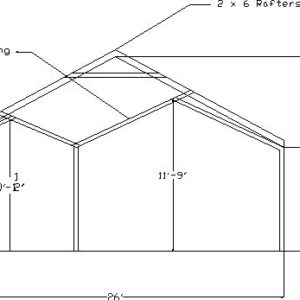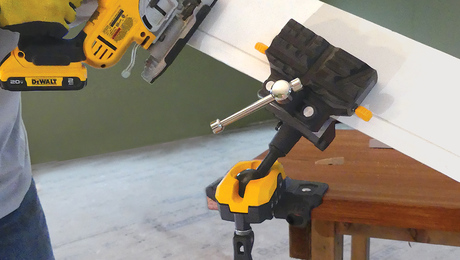I’m starting the remodel of an addition on my 1957 ranch home that we have been in for about three years, the addition was added years ago (maybe 25) to the back of the house and is 26′ wide by 20′ deep. I began by looking up into the attic of the addition to see how the ceilings and roof was constructed and was surprised at what I saw. (see attached sketch)
I have read most of the archives about roof construction and the placement of collar and rafter ties and the such, but never read about this type of construction. Is this roof supported correctly by the 2 x 4’s that cross from the off-center wall out to the rafters?
Originally my plan was to open up the two cathedral ceilings into one large room but now I’m not sure that’s possible and would like to get the opinion of the group.
Thanks




















Replies
It looks to me like they just threw together whatever looked good.
You can most likely do the cathedral ceiling that you want. But someone will have to look at it first and exavuate everything to figure out what needs done. No way can we do that from here.
That's normal framing around here. We just never used 2x4's for that. We've used the same size as the rafters and we've used one size smaller but it's all designed by an Architect or Engineer because sometimes you don't need the collar ties, the rafters running from the inside walls to the bottom of the main rafters are enough.
There are many things you can do there to have a full cathedral room if you want but you have to have an Architect or Engineer come and look at your house. You can put a structural ridge in. You can eliminate the structural ridge and set collar ties at a specific height that has to be designed for your roof.
Around here 2x6's are no good for cathedral ceilings for insulation reasons and therefore we furr them down to a minimum of 2x8.
You have many options.
You could do a site-built "scissor truss" (pic below) to span the whole room.
I have done them in the past, but always w/ 2x8 or 2x10 main rafters. Your 2x6's are a little shy. Talk to a local engineer about it.
To me, that looks acceptable excapt that I would have used 2x6 cieling joists. but to change it, you need someone who can analyse those details on site. It certainbly is unique.
As far as the question is it OK like that?
It's 125 YO
it isn't showing signs of failure?
Then it's fine.
Welcome to the
Taunton University of Knowledge FHB Campus at Breaktime.
where ...
Excellence is its own reward!
Thanks for the opinions, I will let you know what I find out and run it passed you guys again.
Got the drywall and insulation down for most of the room so the framing is much easier to see. I will have to post some pics to show how they frame some of the headers and outside walls, a carpenter friend that stopped by had a good laugh.
Asking for his opinion about what he saw and discussing my plans for opening up the room and trying to save the old roof. He said the 2 x 4 cross bracing could easily be removed since it was not doing much for the roof but it was supporting the middle wall. He felt the old rafters and decking were in excellent condition and would not need to be replaced, but, recommended sistering either 2 x 10's or 2 x 12's to each of the existing 2 x 6's rafters and adding 2 x 6 collar ties to all the new rafters. He feels the new rafters would carry the load, allow more room for insulation and the new ceiling could be at the bottom of the collar ties.
Does this sound reasonable?
My understanding is that collar ties have to be pretty low to have any effect. I'm not an engineer, and I can't see your project, but I don't think you're current collar ties are doing much. I wouldn't be surprised if those 2x4's are working with the collar ties to keep your walls from spreading apart. Pull them out and you may not see any issues right away, but might over time.I guess it comes down to what standard you are looking to build to. If it were my house I'd bring in a structural engineer. Your profile says that you are a (non-computer related) engineer. I'm assuming you're not a structural engineer or you wouldn't be asking this. I think your friend is right about the deeper joists being good for insulation, but I suspect he is incorrect about the joists being able to handle the load after removing the angled braces. You know your fried and have to decide if you trust him enough to not consult the engineer. No offense to your friend, but you asked for opinions.If you want to have one big room with a cathedral ceiling, I think you are looking at a structural ridge or the scissors truss someone suggested. Neither is particularly easy, or impossible, but will look different when finished. If you want the ceiling to be the same pitch as the roof, go with the structural ridge. If you don't care, I suspect retro-fitting a truss system will be easier.-Rich
You are confused. A collar tie is by definition the tie member in the upper third portion of the rafters. It is required in high wind zones to keep the ridge from openning up and acting like a hinge with high uplift wind loads.The tie you are thinking of to prevent wall spread and keep things straingth is called a rafter tie. It is sometimes the cieling rafter also. Witha srtructural ridge properly designed and installed with the right hardware, either of these can be eliminated. Trusses will also fulfill the dream
Welcome to the Taunton University of Knowledge FHB Campus at Breaktime. where ... Excellence is its own reward!
Thanks for clarifying that. I've never heard that explained. I've only framed structural ridge roofs. Another thought...I have seen people do a nice job of leaving the collar ties, etc. in a cathedral space and just box them with nice trim.-Rich
I agree with most everything everyone else has said. Most notably, I agree that what you call collar ties are to prevent wind from opening the roof at the ridge. I am not an engineer, but just looking at your drawing I can see two things--one is that the roof load can still spread the outer walls and two, all that is preventing that is the weight of the middle wall (and I suppose, its attachment to the floor, though usually that isn't much to prevent uplift). If, in your remodeling, you decide to remove that middle wall, I could see the roof spreading and the outer walls tipping out at the top.
Right now what you have are paralleograms supporting the roof and those are not structurally stable. You either need to triangulate and make them into scissors trusses, or at least put a series of vertical members from the middle wall up to the rafters. Then you at least have a direct load path down from the roof. Incidentally, I hope the floor under that middle wall is well supported. As it is now, with the roof loads tending to lift the center wall, I suppose support under it isn't that important.